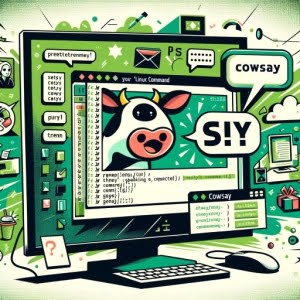Making Linux ASCII Art with the ‘cowsay’ Command

Ever wondered how to add a touch of humor and creativity to your Linux terminal? You’re not alone. Many developers find themselves in need of a break from the monotony, and that’s where the ‘cowsay’ command comes into play. Think of ‘cowsay’ as a fun-loving friend in your terminal – it takes your input and returns it as a message from an ASCII art cow.
This guide will walk you through the basics of using ‘cowsay’, and by the end, you’ll be having fun and impressing your colleagues with your command line wit. We’ll explore ‘cowsay’s’ core functionality, delve into its advanced features, and even discuss common issues and their solutions.
So, let’s dive in and start mastering the ‘cowsay’ command in Linux!
TL;DR: How Do I Use the Cowsay Command in Linux?
To use the ‘cowsay’ command in Linux, you simply type
'cowsay'followed by your message in quotes. For instance,cowsay 'Hello, world!'.
Here’s a simple example:
cowsay 'Hello, world!'
# Output:
# ______________
# < Hello, world! >
# --------------
# \ ^__^
# \ (oo)\_______
# (__)\ )\/\
# ||----w |
# || ||
In this example, we’ve used the ‘cowsay’ command to make an ASCII art cow say ‘Hello, world!’. The command ‘cowsay’ is followed by the message we want the cow to say, enclosed in quotes. The output is a fun, visual representation of a cow saying our message.
But the ‘cowsay’ command has more to offer than just talking cows. Continue reading for more detailed examples and advanced usage scenarios.
Table of Contents
- Getting Started with the Cowsay Command in Linux
- Advantages and Potential Pitfalls of Cowsay
- Exploring Advanced Features of the Cowsay Command in Linux
- Combining Cowsay with Other Linux Commands for More Fun
- Overcoming Challenges with the Cowsay Command in Linux
- ASCII Art: The Heart of Cowsay
- The Role of Fun Commands in Linux Culture
- Exploring the World Beyond Cowsay
- Wrapping Up: Mastering the Cowsay Command in Linux
Getting Started with the Cowsay Command in Linux
Before we can start having fun with ‘cowsay’, we need to ensure it’s installed on your system. If it’s not, don’t worry – installing ‘cowsay’ is as simple as running a single command. Here’s how you can do it on a system that uses apt package manager (like Ubuntu):
sudo apt-get install cowsay
On a system that uses yum package manager (like CentOS), you can use:
sudo yum install cowsay
Once installed, you can verify your installation by simply typing ‘cowsay’ in your terminal. If it’s installed correctly, you should see a cow saying ‘Hello, I am a cow!’.
Now, let’s dive into the basic usage of ‘cowsay’. The simplest way to use ‘cowsay’ is to type ‘cowsay’ followed by your message in quotes. Here’s an example:
cowsay 'I love Linux!'
# Output:
# _____________
# < I love Linux! >
# -------------
# \ ^__^
# \ (oo)\_______
# (__)\ )\/\
# ||----w |
# || ||
In this example, we’ve used the ‘cowsay’ command to make an ASCII art cow say ‘I love Linux!’. The command ‘cowsay’ is followed by the message we want the cow to say, enclosed in quotes. The output is a fun, visual representation of a cow saying our message.
Advantages and Potential Pitfalls of Cowsay
The ‘cowsay’ command is a fun way to make your terminal more lively and entertaining. It can be a great way to break the monotony of a long coding session. However, as with any command, there are potential pitfalls to be aware of.
One potential issue is that ‘cowsay’ doesn’t handle multi-line messages very well. If you try to make your cow say a multi-line message, you’ll find that it doesn’t format the message correctly. We’ll discuss how to handle this in the ‘Troubleshooting and Considerations’ section.
Another potential pitfall is that ‘cowsay’ doesn’t check the length of your message. If you give it a very long message, the cow’s speech bubble will be wider than your terminal window, which can make the output hard to read.
Exploring Advanced Features of the Cowsay Command in Linux
Now that we’ve covered the basics, let’s delve into some of the more advanced features of the ‘cowsay’ command. ‘Cowsay’ is not just about cows – it can also display messages from a variety of other ASCII art animals. Plus, you can modify the style of the message, and even combine ‘cowsay’ with other commands for more fun and complexity.
Before we dive into the advanced usage of ‘cowsay’, let’s familiarize ourselves with some of the command-line options or flags that can modify the behavior of the ‘cowsay’ command. Here’s a table with some of the most commonly used ‘cowsay’ options.
| Option | Description | Example |
|---|---|---|
-f | Specifies a different ASCII art animal. | cowsay -f tux 'I love Linux!' |
-e | Changes the eyes of the ASCII art animal. | cowsay -e ^^ 'I love Linux!' |
-T | Changes the tongue of the ASCII art animal. | cowsay -T U 'I love Linux!' |
-n | Removes the wrapping and allows the message to stretch out. | cowsay -n 'I love Linux!' |
-W | Specifies the width of the message. | cowsay -W 20 'I love Linux!' |
-b | Makes the ASCII art animal appear as if it’s dreaming. | cowsay -b 'I love Linux!' |
-d | Makes the ASCII art animal appear dead. | cowsay -d 'I love Linux!' |
-g | Makes the ASCII art animal appear greedy. | cowsay -g 'I love Linux!' |
-p | Makes the ASCII art animal appear paranoid. | cowsay -p 'I love Linux!' |
-s | Makes the ASCII art animal appear stoned. | cowsay -s 'I love Linux!' |
-t | Makes the ASCII art animal appear tired. | cowsay -t 'I love Linux!' |
-w | Makes the ASCII art animal appear wired. | cowsay -w 'I love Linux!' |
-y | Makes the ASCII art animal appear youthful. | cowsay -y 'I love Linux!' |
Now that we have a basic understanding of ‘cowsay’ command line options, let’s dive deeper into the advanced use of ‘cowsay’.
Combining Cowsay with Other Linux Commands for More Fun
The ‘cowsay’ command is a lot of fun on its own, but did you know you can combine it with other Linux commands for even more entertainment? Two such commands are ‘fortune’ and ‘lolcat’.
Adding a Touch of Fortune to Cowsay
The ‘fortune’ command in Linux generates a random adage or quote. When used with ‘cowsay’, it can make your cow (or other ASCII art animal) say something different each time you run the command. Here’s an example:
fortune | cowsay
# Output:
# _________________________
# < Don't let your mind wander -- it's too little to be let out alone. >
# -------------------------
# \ ^__^
# \ (oo)\_______
# (__)\ )\/\
# ||----w |
# || ||
In this example, we’ve piped the output of the ‘fortune’ command into ‘cowsay’. The result is a cow saying a random quote.
Adding Color with Lolcat
The ‘lolcat’ command is another fun Linux command that can be combined with ‘cowsay’. ‘Lolcat’ is a command that generates a rainbow of colors in your terminal. It can be used to add a splash of color to the output of ‘cowsay’. Here’s an example:
cowsay 'I love Linux!' | lolcat
In this example, we’ve piped the output of ‘cowsay’ into ‘lolcat’. The result is a colorful cow saying ‘I love Linux!’.
By combining ‘cowsay’ with other Linux commands like ‘fortune’ and ‘lolcat’, you can add more fun and complexity to your terminal. It’s a testament to the flexibility and creativity that Linux allows.
Overcoming Challenges with the Cowsay Command in Linux
While the ‘cowsay’ command is straightforward and fun to use, you may encounter some issues along the way. Don’t worry – we’ve got you covered. Here are some common problems and their solutions.
Installation Problems
If you’re having trouble installing ‘cowsay’, the issue might be that your package manager doesn’t know where to find it. Make sure your package manager’s list of software is up to date. For example, if you’re using apt, you can update the list with this command:
sudo apt-get update
After updating, try installing ‘cowsay’ again. If you’re still having trouble, it’s possible that ‘cowsay’ is not available in your distribution’s default repositories. In that case, you may need to add a repository that includes ‘cowsay’.
Syntax Errors
If you’re receiving syntax errors when trying to use ‘cowsay’, make sure you’re following the correct syntax. The basic syntax for ‘cowsay’ is:
cowsay 'Your message here'
Ensure your message is enclosed in quotes. If your message contains a quote, escape it with a backslash ().
cowsay 'It\'s a beautiful day!'
# Output:
# ____________________
# < It's a beautiful day! >
# --------------------
# \ ^__^
# \ (oo)\_______
# (__)\ )\/\
# ||----w |
# || ||
In this example, we’ve used a backslash to escape the single quote in ‘It’s’. The cow correctly says ‘It’s a beautiful day!’.
Long Messages
As mentioned earlier, ‘cowsay’ doesn’t handle long messages well by default. If your message is longer than the width of your terminal, ‘cowsay’ will wrap the message, but the formatting may not be what you expect. To fix this, you can use the -n option, which tells ‘cowsay’ not to wrap the text.
cowsay -n 'This is a really, really, really, really, really, really, really, really, really, really, really, really, really, really, really, really, really, really, really, really, really, really long message.'
In this example, the -n option prevents ‘cowsay’ from wrapping the text, allowing the message to stretch beyond the width of the terminal.
Remember, the ‘cowsay’ command is meant to be fun and entertaining. If you’re having trouble, don’t get discouraged. With a little troubleshooting, you can overcome any issues and get back to having fun with ‘cowsay’.
ASCII Art: The Heart of Cowsay
ASCII art, the building block of the ‘cowsay’ command, is a graphic design technique that uses printable characters from the ASCII standard to create images and designs. It’s been around since the early days of computers, when graphic interfaces were a luxury and most interactions with the computer were text-based.
echo -e "Hello, World! \n $(cowsay -f tux 'I love ASCII art!')"
# Output:
# Hello, World!
# _________________
# < I love ASCII art! >
# -----------------
# \
# \
# .--.
# |o_o |
# |:_/ |
# // \ \
# (| | )
# /'\_ _/`\
# \___)=(___/
In the example above, we’ve used the ‘cowsay’ command to make Tux, the Linux penguin, say ‘I love ASCII art!’. This playful use of ASCII art epitomizes the culture of Linux and programming, where fun and creativity often go hand in hand with technical expertise.
The Role of Fun Commands in Linux Culture
Commands like ‘cowsay’, ‘fortune’, and ‘lolcat’ play a significant role in the culture of Linux and programming. They serve as reminders that coding is not just about solving problems and building software – it’s also about creativity, exploration, and having fun.
These commands are a testament to the open-source spirit of Linux, where anyone can contribute, and even seemingly silly ideas can become a part of the system. They encourage programmers to think outside the box, to experiment, and to remember that there’s always room for a touch of whimsy, even in a Linux terminal.
Exploring the World Beyond Cowsay
The ‘cowsay’ command is just the tip of the iceberg when it comes to fun and creative commands in Linux. Its use of ASCII art and the ability to be combined with other commands opens up a world of possibilities for programmers and system administrators alike.
Diving into Shell Scripting and Command Line Art
One exciting area to explore is shell scripting. Shell scripts allow you to automate tasks, making them a powerful tool in any Linux user’s toolkit. You can even incorporate ‘cowsay’ and other fun commands into your scripts to add a touch of personality.
Command line art is another fascinating area to delve into. With commands like ‘cowsay’, ‘lolcat’, and others, you can create colorful, dynamic, and entertaining visuals right in your terminal.
Here’s an example of how you can combine ‘cowsay’ and ‘lolcat’ in a shell script:
#!/bin/bash
for i in {1..5}
do
echo $i | cowsay | lolcat
done
# Output:
# Each iteration of the loop generates a colorful cow saying a number from 1 to 5.
In this example, we’ve created a simple shell script that uses a loop to generate a series of colorful cows, each saying a number from 1 to 5. This is just a simple demonstration, but it shows the potential of combining fun commands with shell scripting.
Further Resources for Exploring Fun Commands in Linux
If you’re interested in learning more about fun commands in Linux, ASCII art, shell scripting, and command line art, here are a few resources to get you started:
- The Art of Command Line: This GitHub repository offers a comprehensive guide to the command line, including a section on fun commands.
- ASCII Art Studio: This software allows you to create your own ASCII art, which you can then use with ‘cowsay’ or other commands.
- Advanced Bash-Scripting Guide: This guide from The Linux Documentation Project provides an in-depth look at shell scripting, including how to incorporate other commands into your scripts.
Wrapping Up: Mastering the Cowsay Command in Linux
In this comprehensive guide, we’ve delved into the whimsical world of the ‘cowsay’ command in Linux, a tool that brings fun and creativity to your terminal by transforming simple text into messages from ASCII art animals.
We started with the basics, learning how to install and use the ‘cowsay’ command. We then expanded our knowledge with advanced use cases, exploring how to modify the appearance of the ASCII art animals and how to use different command-line options to customize the ‘cowsay’ output.
Venturing beyond the standard use, we discovered how to combine ‘cowsay’ with other Linux commands like ‘fortune’ and ‘lolcat’ for more fun and complexity. We also addressed common issues you might encounter when using ‘cowsay’, such as installation problems and syntax errors, providing solutions and workarounds for each challenge.
Here’s a quick comparison of the methods we’ve discussed:
| Method | Fun Factor | Customizability | Complexity |
|---|---|---|---|
| Basic Use | Moderate | Low | Low |
| Advanced Use | High | Moderate | Moderate |
| Combined with Other Commands | Very High | High | High |
Whether you’re just starting out with ‘cowsay’ or looking to level up your command line creativity, we hope this guide has given you a deeper understanding of ‘cowsay’ and its capabilities.
The ‘cowsay’ command is a testament to the creativity and fun that can be found in the Linux terminal. With a bit of imagination and a sense of humor, you can transform your terminal into a stage for ASCII art animals. Happy coding!


